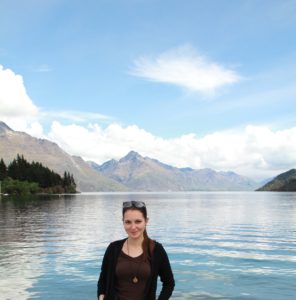
Anastasia is one of the first Bo&MeRanG students to go down under
Anastasia Solomatina started her PhD project in April 2016 in the group of Prof. Kolanus at the LIMES institute. She is part of the Bo&MeRanG program , which is a joint graduate school of the universities of Bonn and Melbourne. This gives the participants the opportunity to do part of their PhD work at their partner laboratory in Australia and receive a PhD from both universities. Anastasia is one of the first Bo&MeRanG students to go to Melbourne and she agreed to answer some questions about her project and her motivation.
- In short, what is your research project about?
My research focus is the in vivo signaling of cytohesin proteins in myeloid cells. I am especially interested in cellular mechanisms which are taking place during bacterial infections. Cytohesin proteins have been reported to play an important role in intracellular signaling such as chemotaxis, cell adhesion, cell migration, protein secretion and rearrangement of the cytoskeleton. One of the key functions of cytohesins is the guanine nucleotide exchange factor (GEF) activity for Arf-GTPases. These Arf-GTPases fulfil a regulatory function in diverse cellular processes such as vesicular trafficking and autophagosome formation. Alteration or dysfunction of this signaling pathway may affect the phagocytosis of intracellular bacteria such as Legionella, as well as its intracellular survival within myeloid cells. To get familiar with the different infection models and to perform some in vivo experiments, I am currently working in our collaborative lab of Prof. Hartland at the University of Melbourne.
- Where did you work before joining the ImmunoSensation Cluster / the Bo&MeRanG program?
I have completed my Bachelor’s and Master’s degree in Biochemistry at the Heinrich-Heine-University in Düsseldorf. During this time, I liked to work in different labs and projects to gain insight into diverse research fields. Therefore, I did my Master’s thesis, which focused on adenovirus mediated cell transformation, at the Heinrich Pette Institute in Hamburg (Leibniz Institute for Experimental Virology). After my graduation I changed to the HIV research group of Dr. Schulze zur Wiesch and Prof. Hauber and worked there as a research assistant before starting my PhD in the Bo&MeRanG program.
- What made you come to Bonn and what do you like about it?
There are two main reasons why I wanted to come to Bonn for my PhD.
The first one is pretty simple. I grew up in Bonn and used to go to school here. After school I lived in different cities and spent some time abroad. So coming back to Bonn would mean to be closer to my friends and family.
The second reason for doing my PhD in Bonn was that I wanted to specialize in immunology and I think the ImmunoSensation Cluster and Bo&MeRanG program provide a great opportunity for cutting edge research and a collobarative network with excellent scientists in this field.
- What do you do when you are not in the lab? What can you recommend especially to anyone travelling to Melbourne?
As a very active and social person I always find something to do when I am not in the lab. I like to meet up with my friends and I am always available for a chat. Furthermore, I like to go for a run or for a hike to relax after hard work. And let’s not forget my biggest passion – travelling.
I guess, everyone who comes to Melbourne falls in love with the city. There are plenty of things to do down here. For a perfect day in Melbourne I would recommend having a pleasant brunch in Brunswick, going for shopping in the CBD, relaxing at St. Kilda Beach, having an authentic Asian dinner in China Town and begin the night in Fitzroy. Don’t forget to check out the hidden laneways of the city, home to many hidden bars and charming restaurants.
Angrit Namislo
